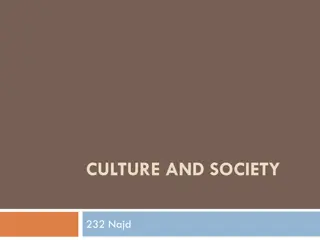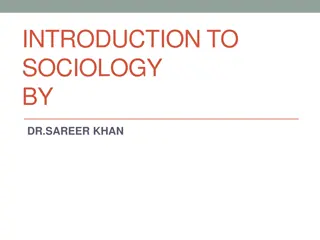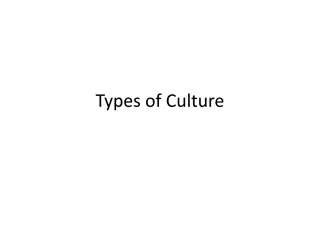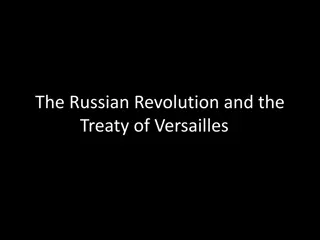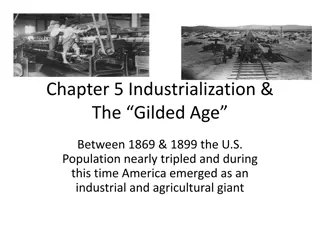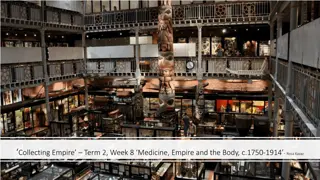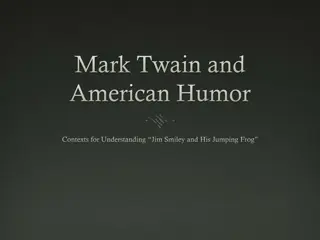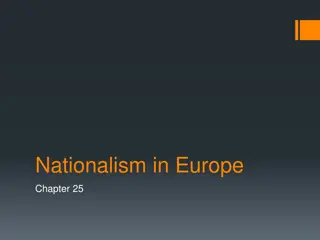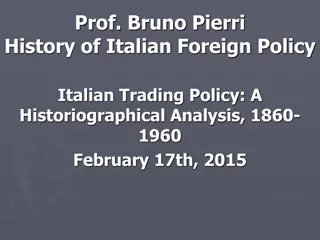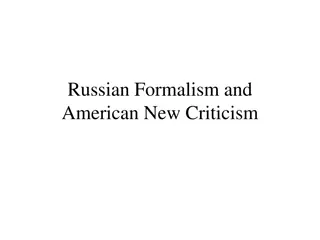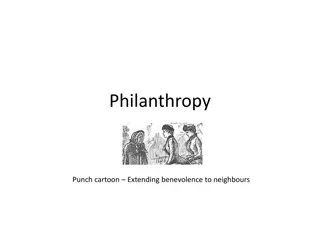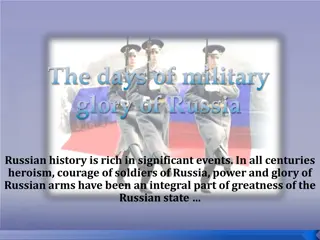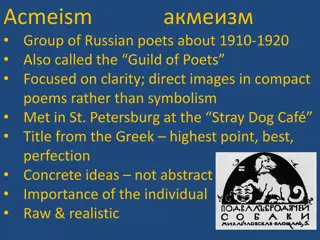Transformation of Russian Society and Culture in the 19th Century
Alexander II and Alexander III led Russia through political reforms and industrialization, impacting the rural landscape. Various political movements emerged, including Populists, anarchists, and Marxists. The Slavophiles advocated for a return to Russia's historical roots. As Russia transitioned from rural to urban, social and political conflicts intensified. Russian society, while initially viewed as backward, embraced Western influences, particularly in literature and philosophy, shaping its cultural identity.
Download Presentation

Please find below an Image/Link to download the presentation.
The content on the website is provided AS IS for your information and personal use only. It may not be sold, licensed, or shared on other websites without obtaining consent from the author. Download presentation by click this link. If you encounter any issues during the download, it is possible that the publisher has removed the file from their server.
E N D
Presentation Transcript
RUSSIAN SOCIETY AND CULTURE . 1855, Alexander II became Tsar of Russia. He led Russia into the political and social reforms, notably the emancipation of serfs. . His successor Alexander III, (1881-1894) continued his restricted policy and it was the period of population growth and significant industrialization, but Russia remained a largely rural country. . The political movements of the time such as Populists, anarchists, and Marxists, and a revolutionary organization called People s Will assassinated Alexander II. . Another current of thoughts was embodied in the Slavophiles (an intellectual movement originating from 19thcentury that wanted the Russian Empire to be developed upon values and institutions derived from its early history. Slavophiles opposed the influences of Western Europe in Russia.
RUSSIAN SOCIETY AND CULTURE During the last decades of the 19thcentury, Russia tried to transform from being rural to urban. The aim to establish the urban life increased the conflict of social and political factors. Concept such as self-rule and discipline, order and disorder increased the conflict in Russia. State and Society made their voices heard especially when tax-paying citizens and educated Russians confronted the people of well-defined position. The city represented the power of the imperial state. Municipal autonomy raised the questions of order and disorder, state and society.
RUSSIAN SOCIETY AND CULTURE At the beginning of the 19th century much of Western Europe viewed Russia as hopelessly backward even Medieval. It was considered more a part of Asia than an outpost of European thought. During the first half of the century, indeed, peasants (called serfs ) were still treated as the property of their feudal masters and could be bought and sold, though they had a few more rights than slaves. Russian serfs gained their freedom only in 1861, two years before the American Emancipation Proclamation. However, the nobility of Russia had looked to the West for ideals and fashions since the early 18th Century, when Peter the Great had instituted a series of reforms aimed at modernizing the country. Russian aristocrats traveled extensively in Western Europe and adopted French as the language of polite discourse. They read French and English literature and philosophy, followed Western fashions, and generally considered themselves a part of modern Europe.
RUSSIAN SOCIETY AND CULTURE Despite the general backwardness of Russian society, its openness to the West (briefly interrupted by Napoleon s 1812 invasion) had profound influences on its literature throughout the 19th Century. The first great national author of Russia, Alexander Pushkin (1799-1837) despite his celebration of Russian history and folklore was profoundly influenced by such English writers as Shakespeare, Byron and Scott. Although he plays a role in Russian literature comparable to that of Goethe in Germany or even Shakespeare in England, his works were little known abroad during his lifetime. It was Ivan Turgenev (1818-1883) who lived and wrote for many years in Europe and was profoundly Western in his outlook that first brought Russian literature to the attention of European readers, but at the cost of often being considered an alien in his own land.
RUSSIAN SOCIETY AND CULTURE It was the twin giants Leo Tolstoy and Fyodor Dostoyevsky whose work exploded out of Russia in the 1870s to overwhelm Europeans with their imaginative and emotional power. To many readers it must have seemed as if this distant, obscure country had suddenly leaped (jumped) to the forefront of contemporary letters. Both were profoundly influenced both by European Romanticism and Realism, but their fiction offered characters more complex and impassioned than those Europeans were used to. Tolstoy is known chiefly for his two masterpieces, War and Peace (1865-1869) and Anna Karenina (1875-1877). These works which wrestle with life s most profound questions earned Tolstoy the reputation of perhaps the world s greatest novelist. The first is a vast portrait of Russia during the period of the Napoleonic wars, and the second the story of a tormented adulterous woman . Like the English Victorian novelists, Tolstoy sought to do more than entertain or even move his readers, taking the writing of fiction seriously as a moral enterprise (project). In the end Tolstoy became a Christian utopian, abandoning fiction altogether. Dostoyevsky is famous for his complex analyses of the human mind. Unlike Turgenev or Tolstoy, he pays little attention to details of setting or the personal appearance of his characters, instead concentrating on their thoughts and emotions. His work and that of Tolstoy revealed to Europeans that modern fiction could serve ends far more sophisticated than it had in the hands of Zola or even Flaubert.
RUSSIAN SOCIETY AND CULTURE Dostoyevsky had a sensational life which is variously reflected in his fiction. He believed his father to have been murdered by his own serfs, a belief which led him to be obsessed with murder as a subject in many of his greatest works, such as Crime and Punishment (1866) Anton Chekhov (1860-1904), whose short stories and plays used Realism in a much more understated (revealed) way. His four great plays written just before and after the turn of the century The Sea Gull, Uncle Vanya, Three Sisters, and The Cherry Orchard, along with the Realist masterworks of the Norwegian Henrik Ibsen helped to rescue the theater from the dismal state into which it had plunged after the time of the German Romantics. The theatrical genius of the 19th century seems to have gone into opera rather than stage plays; few of the plays written between Schiller and Chekhov are remembered or performed today, but his works are seldom absent from the stage for long.
POLITICAL TOPICS SHOULD BE TAKEN INTO CONSIDERATION Alexander II Alexander III Napoleonic Wars Marxists Populist Slavophiles Stalin municipal
ANNA KARENINA/ THEMES Hypocrisy This theme is first touched upon with the novel's epigraph: "Vengeance is mine, I shall repay." This epigraph is a warning to both Russian Society and to the reader that the only person allowed to judge is God. The rest of us, being imperfect, merely make ourselves into hypocrites when we judge someone else. Russian Society is full of hypocrites in this book indeed, the very corruption of this society is symbolized by the way socialites treat Anna after she elopes with Vronsky. Although most members of Russian Society (men and women included) conduct extra-marital affairs, they turn on Anna when it turns out that her affair goes deeper than mere carnal desire. Princess Betsy is an excellent example of the hypocrisy in Russian Society.
ANNA KARENINA/ THEMES Jealousy Anna Karenina features portraits of three relationships: Dolly and Oblonsky, Kitty and Levin, and Anna and Vronsky. In all three of these relationships, jealousy plays a role that affects the success of the relationship. In general, the less jealous a couple are, the more successful they will be. Dolly is jealous when Oblonsky is unfaithful, but she represses this feeling for the good of their children and their home, and they stay together as a result. Levin and Kitty are jealous of each other at first, but as they grow into themselves and their relationship (and, in Levin's case, his relationship with God), their jealousy fades and their relationship strengthens. Finally, Anna's relationship with Vronsky is destroyed by her all-consuming jealousy.
ANNA KARENINA/ THEMES Faith Faith is the overriding aspect of Levin's story. Tortured by existential doubts throughout most of the book, he experiences an epiphany at the end that shows him the reason for his existence. By learning to have faith in God, and following His rules, Levin experiences the joyful peace that is faith. Faith also saves his relationship with Kitty, because he learns that he must place his life in the hands of the Lord, and not look at Kitty to be his Savior. Fidelity Like jealousy, fidelity is a concern of the three relationships highlighted in the novel. When a young man flirts with Kitty, Levin "already saw himself as a deceived husband, who was needed by his wife and her lover only in order to provide them with the comforts of life and with pleasures." Meanwhile, Dolly's trust in Oblonsky is shattered when she learns that he has been unfaithful. And, due to double standards of fidelity for men and women, Anna is punished the most of all for her infidelity. (Though, it must be said, that Anna also abandoned her husband and son, thereby causing the most damage.) The importance of fidelity at least the fidelity of women is underlined throughout the novel.
ANNA KARENINA/ THEMES Family The importance of the family, and of keeping the family intact, is one of the most important aspects of Anna Karenina. This includes the extended family as well for example, one of the reasons why the Shcherbatskaya daughters are presented as the epitome of virtuous women is that they care not just for their husbands but for their parents and for their husbands' families. (Kitty, for example, gains a great deal of Levin's esteem after she cares for his dying brother Nicholas.) And one of Anna's biggest concerns about getting a divorce from Karenina is that she will no longer have access to her beloved son. Marriage Tolstoy presents portraits of marriage that are astonishing for their lack of romance. Although these women are princesses, baronesses and countesses, there are no fairy-tale endings in Anna Karenina. Instead, marriage is portrayed with all of its faults and problems, from jealousy to lack of passion to abandonment. Tolstoy does not advocate the ending of marriage as a social institution at all indeed, he believes it is the glue that holds societies together, but he is realistic about how it works. The only fully successful marriage in Anna Karenina is between Levin and Kitty, and it only becomes that way when they understand that a man and a woman occupy separate social roles, and that it is necessary for a couple to give each other space.
ANNA KARENINA/ THEMES Society Russian High Society comes in for a beating in Anna Karenina. The hypocrisies and petty, small-minded beliefs of Society are painstakingly documented from their condemnation of Anna to their crusade to "save" the Slavs at the end of the book. But Tolstoy also offers an amazing portrayal of Society's rules and rituals: dinners, balls, parties, horse-riding and croquet games. And social interaction is vital to the health of a relationship: one of the major reasons why Anna is so jealous of Vronsky is because he has the freedom to move in society, whereas she has been cast out from society. Progress While Tolstoy was writing Anna Karenina, Russia was experiencing an influx of Western thought, politics, and technology. This was popularly known as "progress," and many intellectuals in the novel, such as Koznyshev, applaud the changes that have gone on in Russia due to these Western influences. One of Tolstoy's major projects in Anna Karenina is to question the "improvements" that are happening to Russia due to Western "progress." The train, for example, a symbol of evil and death in Anna Karenina, came from the West. Virtually everything Koznyshev says is derided by another, more credible character, such as Levin or Dolly. Instead of regarding Western things as progress, Tolstoy champions the Russian land and Russian traditions.
ANNA KARENINA/ THEMES Carnal Desire In Anna Karenina, carnal desire is a destructive force. Anna and Vronsky do not create but destroy Anna becomes sterile, Vronsky abandons his career, Karenina is ruined, and Seroyzha loses his mother all in the name of carnal desire. This is a reflection of Tolstoy's Christian message. "The Land" The Land takes on a spiritual aspect in this book. The scenes of Levin planting with his peasants are reverent in their sensuality. Throughout the book there are many questions about the land and the people who work it (peasants), all based on real political questions that Russia was asking itself at the time. Levin becomes very concerned with these issues and implements a communal agricultural theory. Tolstoy believes strongly in the primacy of the land to Russian well-being; one of his major concerns about Western progress is that it seemed to focus on cities and abandon the land. Indeed, only the characters who regularly connect to the land by either living on it, as Levin does, or escaping the city often to be in the country, as Dolly does are fully sympathetic characters.
ANNA KARENINA/ THEMES The City Urban fashionable and seductive, but they lead to evil things. Russian Society is centered in St. Petersburg and Moscow; all the new ideas from Europe arrive in the cities first. As if to prove the corruption of these places, Levin always feels uncomfortable in cities, whereas Anna feels out of sorts away from them. Passion Passion is distrusted in Anna Karenina because it can lead to destruction, as it does in Anna's case. But Anna's double, Levin is also an extremely passionate individual, and his passion is championed because it leads him to the Lord. In general, passion itself is not a bad force, but it can be easily corrupted and lead to problems. centers are hotbeds of corruption and destruction. They are


